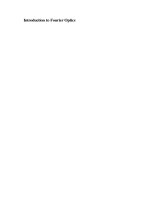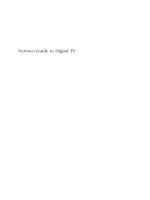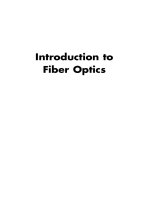crisp, j. (2001). introduction to fiber optics (2nd ed.)
Bạn đang xem bản rút gọn của tài liệu. Xem và tải ngay bản đầy đủ của tài liệu tại đây (2.49 MB, 238 trang )
Introduction to
Fiber Optics
Prelims 3/5/01 11:48 Page i
Prelims 3/5/01 11:48 Page ii
Introduction to
Fiber Optics
2nd Edition
John Crisp
OXFORD AUCKLAND BOSTON JOHANNESBURG MELBOURNE NEW DELHI
Prelims 3/5/01 11:48 Page iii
Newnes
An imprint of Butterworth–Heinemann
Linacre House, Jordan Hill, Oxford OX2 8DP
A division of Reed Educational and Professional Publishing Ltd
A member of the Reed Elsevier plc group
First published 1996
Reprinted 1997, 1998, 1999, 2000 (three times), 2001
Second edition 2001
© John Crisp 1996, 2001
All rights reserved. No part of this publication may be reproduced in any material form
(including photocopying or storing in any medium by electronic means and whether or
not transiently or incidentally to some other use of this publication) without the written
permission of the copyright holder except in accordance with the provisions of the
Copyright, Designs and Patents Act 1988 or under the terms of a licence issued by the
Copyright Licensing Agency Ltd, 90 Tottenham Court Road, London, England W1P 0LP.
Applications for the copyright holder’s written permission to reproduce any part of this
publication should be addressed to the publishers.
British Library Cataloguing in Publication Data
A catalogue record for this book is available from the British Library
ISBN 07506 50303
Composition by Scribe Design, Gillingham, Kent
Printed and bound in Great Britain by Biddles Ltd, www.biddles.co.uk
Prelims 3/5/01 11:48 Page iv
Preface vii
1 Optic fiber and light — a brilliant combination 1
2 What makes the light stay in the fiber? 9
3 The choice of frequency 17
4 Propagation of light along the fiber 22
5 Decibels 39
6 Losses in optic fibers 50
7 Dispersion and our attempts to prevent it 59
8 Real cables 68
9 Connecting optic fibers — the problems 82
10 Fusion splicing 92
11 Mechanical splices 103
12 Connectors 108
13 Couplers 126
14 Light sources and detectors 139
15 Testing a system 147
16 System design — or, will it work? 166
17 The transmission of signals 183
18 Organizing optic fiber within a building 192
19 LANs and topology 200
Contents
Prelims 3/5/01 11:48 Page v
20 Some final thoughts 206
Glossary 210
Quiz time answers 217
Index 227
Contents
vi
Prelims 3/5/01 11:48 Page vi
An increasing proportion of the world’s communications are carried by fiber
optic cables. It has spread quietly, almost without being noticed into every situa-
tion in which information is being transmitted whether it is within the home
hi-fi system, cable television or telecommunication cables under the oceans.
The purpose of this book is to provide a worry-free introduction to the subject.
It starts at the beginning and does not assume any previous knowledge of the
subject and, in gentle steps, it introduces the theory and practical knowledge
that is necessary to use and understand this new technology.
In learning any new subject jargon is a real problem. When the words are
understood by all parties they make an efficient shorthand form of communi-
cation. Herein lies the snag. If not understood, jargon can create an almost
impenetrable barrier to keep us out. In this book jargon is introduced only when
required and in easily digested snacks.
John Crisp
Preface
Prelims 3/5/01 11:48 Page vii
Prelims 3/5/01 11:48 Page viii
The starting point
For thousands of years we have used light to communicate. The welcoming
camp fire guided us home and kept wild animals at bay. Signal bonfires were
lit on hilltops to warn of invasion. Even in these high-tech days of satellite
communications, ships still carry powerful lamps for signaling at sea, signaling
mirrors are standard issue in survival packs.
It was a well known ‘fact’ that, as light travels in straight lines, it is impossible
to make it follow a curved path to shine around corners.
Boston, Mass., USA, 1870. An Irish physicist by the name of John Tyndall gave
a public demonstration of an experiment which not only disproved this belief
but gave birth to a revolution in communications technology.
His idea was very simple. He filled a container with water and shone a light into
it. In a darkened room, he pulled out the bung. The light shone out of the hole
and the water gushed out.
It was expected that the light would shine straight out of the hole and the water
would curve downwards — as shown in Figure 1.1.
Now see Figure 1.2 for what actually happened.
The light stayed inside the water column and followed the curved path. He had
found a way to guide light!
The basic requirements still remain the same today — a light source and a clear
material (usually plastic or glass) for the light to shine through. The light can be
guided around any complex path as in Figure 1.3.
1
1
Optic fiber and light — a
brilliant combination
ch01 3/5/01 11:48 Page 1
Being able to guide light along a length of optic fiber has given rise to two
distinct areas of use, light guiding and communications.
Light guiding
There are many applications of light guiding — and more are being devised
every day.
Here are a few interesting examples.
Introduction to Fiber Optics
2
Figure 1.1
What was
expected to
happen
Figure 1.2
What actually
happened
Figure 1.3
Light can go
anywhere
ch01 3/5/01 11:48 Page 2
Road signs
A single light source can be used to power many optic fibers. This technique is
used in traffic signs to indicate speed limits, lane closures etc. The light source is
built into a reflector. The front face of the reflector can then be covered with the
ends of a whole series of optic fibers. These optic fibers convey the light to the
display board where they can be arranged to spell out the message (Figure 1.4).
This method has the advantage that, since the whole display is powered by one
electric light bulb, we never get the situation where the message can be misread
— it is either all there or it’s all missing.
The same method can be used to illuminate instrument panels. Instead of a
series of separate light bulbs, one of which is bound to be unlit at any critical
time, the whole display is powered by a single bulb — with a spare one ready
to switch in when required.
Endoscopes
As the light travels down the fiber, light rays get thoroughly jumbled up. This
means that a single fiber can only carry an average value of the light that enters
it. To convey a picture along a single fiber is quite impossible. To produce a
picture, a large number of optic fibers must be used in the same way that many
separate points of light, or pixels, can make an image on a cathode ray tube.
This is the principle of an endoscope used by doctors to look inside of us with
the minimum of surgery (Figure 1.5). This is a bundle of around 50,000 very thin
fibers of 8 µm (315 millionths of an inch) diameter, each carrying a single light
Optic fiber and light – a brilliant combination
3
Figure 1.4
Each fiber goes to
one of the ‘lights’
ch01 3/5/01 11:48 Page 3
level. An endoscope is about one meter in length with a diameter of about 6 mm
or less. For illumination, some of the fibers are used to convey light from a 300
watt xenon bulb. A lens is used at the end of the other fibers to collect the picture
information which is then often displayed on a video monitor for easy viewing.
To rebuild the image at the receiving end, it is essential that the individual fibers
maintain their relative positions within the endoscope otherwise the light infor-
mation will become scrambled. Bundles of fibers in which the position of each
fiber is carefully controlled are called coherent bundles (Figure 1.6).
Many fiber endoscopes are in everyday use, although the move now is towards
the use of miniature cameras instead of fibers.
Hazardous areas
If we have a tank containing an explosive gas, a safe form of illumination is
essential. One solution is to use a light source situated a safe distance away from
the tank, and transmit the light along an optic fiber. The light emitted from the
end of the fiber would not have sufficient power to ignite the gas.
All at sea
Lighting on both ships and small boats is more difficult and more critical than
lighting a building.
The marine environment is very hostile to electrical installations. The salt water
is highly corrosive to the brass and copper used to make the connections to the
lights and the corrosive spray envelops the largest ship or the smallest harbor
launch.
Introduction to Fiber Optics
4
Figure 1.5
An endoscope
Figure 1.6
A coherent bundle
(top) gives a good
image. If it’s not
coherent (bottom)
the image is
scrambled
ch01 3/5/01 11:48 Page 4
Imagine a dark winter’s night, a gale is blowing spray in horizontal sheets and
our harbor launch is heading out to sea to meet the incoming ship. The
mountainous seas crash into our launch and we need both our hands to avoid
being swept overboard.
Lighting is no longer a nice-to-have like the streetlight outside our house, it is
vital and in many situations our lives will depend on it.
In this environment optic fibers have much to offer in reliability, visibility and
ease of maintenance.
A single light source can be used to illuminate many different locations at the
same time. Optic fibers can convey the light to the exact place it is needed so
we can see the edge of a step, the edge of the deck or the next hand-hold as
we stumble along the deck in total blackness. By using filters, we can even
add colors to each light to reduce glare or to identify different positions or
controls. An optic fiber can also provide the ultimate in underwater inspec-
tion lights.
It not only allows us to have light just where we need it but we can have just
the amount that we need. Too much light is often as irritating as too little as it
causes glare and loss of our night vision. This can mean 20 minutes or so before
our eyes fully readjust to the darkness.
Reliability is much enhanced by enabling the light source and all the electrical
wiring to be mounted below decks in a dry environment. Changing the light
source is very easy — much appreciated by anyone who has climbed a mast on
a winter’s night to change the bulb in a navigation light. Physical damage can
damage one of the optic fibers but the others will continue working. Contact
details are given in the bibliography at the end of the book.
Flexible lighting
If an optic cable allows light to escape it may be of no use for data communi-
cation but it can make very innovative light sources with virtually endless uses.
A 320 mW visible light laser can cause over 200 m (660 ft) of the fiber to glow
and, being powered by a sealed battery, it can provide up to three hours of light,
safe enough for use in hostile environments, such as with explosive gases, and
hardy enough to withstand the worst environments. The system can be
completely portable or permanently installed into a building.
The range of fibers extend from ultra thin silica of 0.7 mm (about 1/32 in) diame-
ter for permanent installation in buildings to a highly flexible cable with a plastic
giving a minimum bend radius of only 5 mm (1/5th in) and an overall diameter
of 8 mm (1/3rd in).
The cladding is FEP, a plastic similar to PTFE, and has three properties that make
it ideal for a wide range of environments. It is very chemical resistant, it is
unaffected by water and can operate over an extreme range of temperatures.
Having read through the above characteristics, it is much easier to think of
new uses than it is to imagine lighting situations in which it would not be
appropriate.
Optic fiber and light – a brilliant combination
5
ch01 3/5/01 11:48 Page 5
Here are a few applications: marking escape routes for fire fighters, mountain and
mine rescue, underwater routes for divers, helicopter landing zones, oil refiner-
ies, planes, ships, tunnels. The list is almost endless (see Bibliography, p.208).
Communications
In 1880, only four years after his invention of the telephone, Alexander Graham
Bell used light for the transmission of speech. He called his device a Photo-
phone. It was a tube with a flexible mirror at its end. He spoke down the tube
and the sound vibrated the mirror. The modulated light was detected by a
photocell placed at a distance of two hundred meters or so. The result was
certainly not hi-fi but the speech could at least be understood.
Following the invention of the ruby laser in 1960, the direct use of light for
communication was re-investigated. However the data links still suffered from
the need for an unobstructed path between the sender and the receiver. Never-
theless, it was an interesting idea and in 1983 it was used to send a message,
by Morse code, over a distance of 240 km (150 miles) between two mountain
tops.
Enormous resources were poured into the search for a material with sufficient
clarity to allow the development of an optic fiber to carry the light over long
distances.
The early results were disappointing. The losses were such that the light power
was halved every three meters along the route. This would reduce the power by
a factor of a million over only 60 meters (200 feet). Obviously this would rule
out long distance communications even when using a powerful laser. Within
ten years however, we were using a silica glass with losses comparable with the
best copper cables.
The glass used for optic fiber is unbelievably clear. We are used to normal
‘window’ glass looking clear but it is not even on the same planet when
compared with the new silica glass. We could construct a pane of glass several
kilometers thick and still match the clarity of a normal window. If water were
this clear we would be able to see the bottom of the deepest parts of the ocean.
We occasionally use plastic for optic fiber but its losses are still impossibly high
for long distance communications but for short links of a few tens of meters it
is satisfactory and simple to use. It is finding increasing applications in hi-fi
systems, and in automobile control circuitry.
On the other hand, a fiber optic system using a glass fiber is certainly capable
of carrying light over long distances. By converting an input signal into short
flashes of light, the optic fiber is able to carry complex information over
distances of more than a hundred kilometers without additional amplification.
This is at least five times better than the distances attainable using the best
copper coaxial cables.
The system is basically very simple: a signal is used to vary, or modulate, the
light output of a suitable source — usually a laser or an LED (light emitting
diode). The flashes of light travel along the fiber and, at the far end, are
Introduction to Fiber Optics
6
ch01 3/5/01 11:48 Page 6
converted to an electrical signal by means of a photo-electric cell. Thus the
original input signal is recovered (Figure 1.7).
When telephones were first invented, it took 75 years before we reached a
global figure of 50 million subscribers. Television took only 13 years to achieve
the same penetration and the Internet passed both in only four years. As all three
of these use fiber optics it is therefore not surprising that cables are being laid
as fast as possible across all continents and oceans. Optic fibers carry most of
the half million international telephone calls leaving the US everyday and in the
UK over 95% of all telephone traffic is carried by fiber. Worldwide, fiber carries
85% of all communications. Some of the main international routes are shown
in Figure 1.8.
Terminology
A brief note on some terms: optic fiber, fiber optics and fiber.
᭟
᭟ optic fiber is the transparent material, along which we can transmit
light.
᭟
᭟ fiber optics is the system, or branch of engineering concerned with
using the optic fibers. Optic fiber is therefore used in a fiber optic
system.
᭟
᭟ fiber is a friendly abbreviation for either, so we could say that fiber is
used in a fiber system.
Optic fiber and light – a brilliant combination
7
Figure 1.7
A simple fiber
optic system
Figure 1.8
Some of the main
undersea fiber
routes
ch01 3/5/01 11:48 Page 7
Quiz time 1
In each case, choose the best option.
1 A transparent material along which we can transmit light is called:
(a) a fiber optic
(b) a flashlight
(c) an optic fiber
(d) a xenon bulb
2 A simple fiber optic system would consist of:
(a) a light source, an optic fiber and a photo-electric cell
(b) a laser, an optic fiber and an LED
(c) a copper coaxial cable, a laser and a photo-electric cell
(d) an LED, a cathode ray tube and a light source.
3 Optic fiber is normally made from:
(a) coherent glass and xenon
(b) copper
(c) water
(d) silica glass or plastic
4 It is not true that:
(a) endoscopes use coherent bundles of fibers
(b) silica glass is used because of its clarity
(c) a photocell converts light into electric current
(d) plastic fiber is normally used for long distance communications
5 Plastic optic fibers:
(a) have lower losses than glass fibers
(b) are used in the automobile industry
(c) are suitable for long-distance communications
(d) are used as a form of electrical to optical converter
Introduction to Fiber Optics
8
ch01 3/5/01 11:48 Page 8
Refraction
Imagine shining a flashlight. The light waves spread out along its beam. Looking
down and seeing the wave crests it would appear as shown in Figure 2.1.
As we move further from the light source, the wavefront gets straighter and
straighter.
At a long distance from the light source, the wavefront would be virtually straight.
In a short interval of time each end of the wavefront would move forward a set
distance.
9
2
What makes the light
stay in the fiber?
Figure 2.1
The wavefront
becomes straighter
ch02 3/5/01 11:49 Page 9
If we look at a single ray of light moving through a clear material the distance
advanced by the wavefront would be quite regular as shown in Figure 2.2.
There is a widely held view that light always travels at the same speed. This
‘fact’ is simply not true. The speed of light depends upon the material through
which it is moving. In free space light travels at its maximum possible speed,
close to 300 million meters or nearly eight times round the world in a second.
When it passes through a clear material, it slows down by an amount depen-
dent upon a property of the material called its refractive index. For most materi-
als that we use in optic fibers, the refractive index is in the region of 1.5.
So:
Speed of light in the material =
Units
As the refractive index is simply a ratio of the speed of light in a material to the
speed of light in free space, it does not have any units.
Using the example value of 1.5 for the refractive index, this gives a speed of
about 200 million meters per second. With the refractive index on the bottom
line of the equation, this means that the lower the refractive index, the higher
would be the speed of light in the material. This is going to be vital to our expla-
nation and is worth emphasizing:
lower refractive index = higher speed
Let’s have a look at a ray of light moving from a material of high refractive index
to another material with a lower index in which it would move faster. We can
see that the distances between the successive wave crests, or the wavelength,
will increase as soon as the light moves into the second material.
Now, the direction that the light approaches the boundary between the two
materials is very significant. In Figure 2.3 we choose the simplest case in which
the light is traveling at right angles to the boundary.
We will now look at a ray approaching at another angle. As the ray crosses the
boundary between the two materials, one side of the ray will find itself travel-
ing in the new, high velocity material whilst the other side is still in the original
speed of light in free space
ᎏᎏᎏᎏ
refractive index
Introduction to Fiber Optics
10
Figure 2.2
The wavefront
moves forward
ch02 3/5/01 11:49 Page 10
material. The result of this is that the wavefront progresses further on one side
than on the other. This causes the wavefront to swerve. The ray of light is now
wholly in the new material and is again traveling in a straight line albeit at a
different angle and speed (Figure 2.4).
The amount by which the ray swerves and hence the new direction is deter-
mined by the relative refractive indices of the materials and the angle at which
the ray approaches the boundary.
Snell’s law
The angles of the rays are measured with respect to the normal. This is a line
drawn at right angles to the boundary line between the two refractive indices.
The angles of the incoming and outgoing rays are called the angles of incidence
and refraction respectively.
What makes the light stay in the fiber?
11
Figure 2.3
The light changes
its speed
Figure 2.4
The light is
refracted
ch02 3/5/01 11:49 Page 11
These terms are illustrated in Figure 2.5.
Notice how the angle increases as it crosses from the higher refractive index
material to the one with the lower refractive index.
Willebrord Snell, a Dutch astronomer, discovered that there was a relationship
between the refractive indices of the materials and the sine of the angles. He
made this discovery in the year 1621.
Snell’s law states the relationship as:
n
1
sin
φ
1
= n
2
sin
φ
2
Where: n
1
and n
2
are the refractive indices of the two materials, and sin
φ
1
and
sin
φ
2
are the angles of incidence and refraction respectively.
There are four terms in the formula so provided that we know three of them, we
can always transpose it to find the other term.
We can therefore calculate the amount of refraction that occurs by using Snell’s
law.
A worked example
Calculate the angle shown as
φ
2
in Figure 2.6.
The first material has a refractive index of 1.51 and the angle of incidence is 38°
and the second material has a refractive index of 1.46.
Starting with Snell’s law:
n
1
sin
φ
1
= n
2
sin
φ
2
Introduction to Fiber Optics
12
Figure 2.5
The names of the
parts
ch02 3/5/01 11:49 Page 12
We know three out of the four pieces of information so we substitute the known
values:
1.51sin38° = 1.46sin
φ
2
Transpose for sin
φ
2
by dividing both sides of the equation by 1.46. This gives us:
ᎏ
1.51
1
s
.4
in
6
38°
ᎏ
= sin
φ
2
Simplify the left hand side:
0.6367 = sin
φ
2
The angle is therefore given by:
φ
2
= arcsin0.6367
So:
φ
2
= 39.55°
Critical angle
As we saw in the last section, the angle of the ray increases as it enters the mater-
ial having a lower refractive index.
As the angle of incidence in the first material is increased, there will come a
time when, eventually, the angle of refraction reaches 90° and the light is
refracted along the boundary between the two materials. The angle of incidence
which results in this effect is called the critical angle.
We can calculate the value of the critical angle by assuming the angle of refrac-
tion to be 90° and transposing Snell’s law:
n
1
sin
φ
1
= n
2
sin90°
What makes the light stay in the fiber?
13
Figure 2.6
An example using
Snell’s law
ch02 3/5/01 11:49 Page 13
As the value of sin90° is 1, we can now transpose to find sin
φ
1
, and thence
φ
1
,
(which is now the critical angle):
φ
critical
= arcsin
ᎏ
n
n
2
1
ᎏ
A worked example
A light ray is traveling in a transparent material of refractive index 1.51 and
approaches a second material of refractive index 1.46. Calculate the critical
angle.
Using the formula for the critical angle just derived:
φ
critical
= arcsin
ᎏ
n
n
2
1
ᎏ
Put in the values of the refractive indices:
φ
critical
= arcsin
ᎏ
1
1
.
.
4
5
6
1
ᎏ
Divide the two numbers:
φ
critical
= arcsin(0.9669)
So:
φ
critical
= 75.2°
Total internal reflection
The critical angle is well-named as its value is indeed critical to the operation
of optic fibers.
At angles of incidence less than the critical angle, the ray is refracted as we saw
in the last section.
However, if the light approaches the boundary at an angle greater than the criti-
cal angle, the light is actually reflected from the boundary region back into the
first material. The boundary region simply acts as a mirror. This effect is called
total internal reflection (TIR).
Figure 2.7 shows these effects.
The effect holds the solution to the puzzle of trapping the light in the fiber. If
the fiber has parallel sides, and is surrounded by a material with a lower refrac-
tive index, the light will be reflected along it at a constant angle – shown as ø
in the example in Figure 2.8.
Any ray launched at an angle greater than the critical angle will be propa-
gated along the optic fiber. We will be looking at this in more detail in
Chapter 4.
Introduction to Fiber Optics
14
ch02 3/5/01 11:49 Page 14
Quiz time 2
In each case, choose the best option.
1 The speed of light in a transparent material:
(a) is always the same regardless of the material chosen
(b) is never greater than the speed of light in free space
(c) increases if the light enters a material with a higher refractive index
(d) is slowed down by a factor of a million within the first 60 meters
2 A ray of light in a transparent material of refractive index 1.5 is
approaching a material with a refractive index of 1.48. At the
boundary, the critical angle is:
(a) 90°
(b) 9.4°
(c) 75.2°
(d) 80.6°
What makes the light stay in the fiber?
15
Figure 2.7
Total internal
reflection
Figure 2.8
Light can bounce
its way along the
fiber
ch02 3/5/01 11:49 Page 15
3 If a ray of light approaches a material with a greater refractive
index:
(a) the angle of incidence will be greater than the angle of refraction
(b) TIR will always occur
(c) the speed of the light will increase immediately as it crosses the
boundary
(d) the angle of refraction will be greater than the angle of incidence
4 If a light ray crosses the boundary between two materials with
different refractive indices:
(a) no refraction would take place if the angle of incidence was 0°
(b) refraction will always occur
(c) the speed of the light will not change if the incident ray is traveling
along the normal
(d) the speed of light never changes
5 The angle ? in Figure 2.9 has a value of:
(a) 80.6°
(b) 50°
(c) 39.3°
(d) 50.7°
Introduction to Fiber Optics
16
Figure 2.9
Question 5:
calculate the
angle ?
ch02 3/5/01 11:49 Page 16
Electromagnetic waves
Radio waves and light are electromagnetic waves. The rate at which they alter-
nate in polarity is called their frequency (f ) and is measured in Hertz (Hz), where
1 Hz = 1 cycle per second.
The speed of the electromagnetic wave (v) in free space is approximately
3 ϫ 10
8
ms
–1
. The term ms
–1
means meters per second.
The distance traveled during each cycle, called the wavelength () can be calcu-
lated by the relationship:
wavelength =
ᎏ
sp
f
e
r
e
e
d
qu
o
e
f
n
l
c
ig
y
ht
ᎏ
In symbols, this is:
=
ᎏ
v
f
ᎏ
By transposing we get the alternative forms:
frequency =
ᎏ
sp
w
e
a
e
v
d
el
o
e
f
n
l
g
ig
th
ht
ᎏ
f =
ᎏ
v
ᎏ
and:
speed of light = frequency ϫ wavelength (v = f)
17
3
The choice of frequency
ch03 3/5/01 11:50 Page 17









